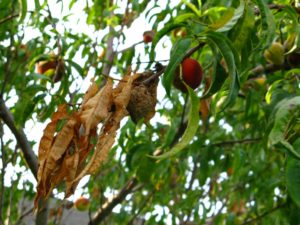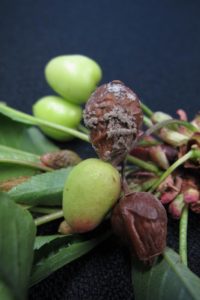We are already receiving reports of brown rot, caused by several different types of the fungus Monilinia., Many of these are causing shoot blight, but we are receiving samples of brown rot on cherry fruit.
Brown rot is a common and destructive disease of stone fruit, a closely related group of trees that include peach, nectarine, apricot, plum, and cherry. Another type of brown rot, European brown rot, caused by Monilinia laxa, appears to be limited to sour cherries in some northern regions of the Midwest, but has not been found (yet!) in Indiana.
Symptoms and signs of infection include blossom and twig blight, cankers, and fruit rot on all the members of the stone fruit group. Symptoms first appear in the spring as blossoms become infected. Diseased flowers wilt and turn brown, but remain attached to the tree. The fungus may produce masses of tan spores on the dead blossoms. Flower infections may spread to both new growth and spurs, causing cankers and shoot death as the fungus spreads into twigs.
Young fruit is normally resistant to brown rot but can become infected through wounds, like plum curculio damage, or sunscald. As fruit matures, it becomes more susceptible to infection, even in the absence of wounds. Fruit infections appear as soft brown spots that expand rapidly and become covered with powdery, tan spores (Figure 1). Infection can spread into adjacent branches, causing dieback or death (Figure 2). An entire peach can be rotted in as little as two days, after which it shrinks into a wrinkled “mummy”. Rotted fruit and mummies may remain on the tree or fall to the ground (Figure 3). During harvest, injured fruit are easily colonized and can rot within a few days.
The brown rot fungus survives the winter primarily in mummified fruits, but also survives in twig and branch cankers. During blossom time, mummified fruit on the ground develop a multitude of small, tan, wineglass-shaped structures called apothecia. The inside of these apothecia are lined with thousands of spore-containing sacs (asci) filled with spores that are forcibly discharged with changes of wind and barometric pressure. Spores that land on wet blossoms or new shoots will infect if they remain wet for longer than five hours. Infected blossoms wilt and powdery masses of tan spores (conidia), develop on the flower shuck. The infection can progress from the flower into the spur, then the twig, where it forms a canker. Conidia continue to be produced throughout early summer to infect injured and ripening fruit. Wet weather and temperatures ranging from 60 to 70 °F are most favorable for disease development.
It is easy to see from Figure 1 that the spores of this fungus are everywhere, and that any type of injury to ripening fruit (insect, hail, twig rubs, picking injury) will provide an entry point for the brown rot fungus. Upon harvest, immediately cool, refrigerate, or process fruit.
The key to managing this disease is to keep spore numbers low by good sanitation practices and regular applications of fungicides. Promptly remove and destroy fallen and rotted fruit. Remove any mummies remaining on the tree should as well. Prune out cankers in late winter, during the dormant season, and remove any wild (cherry or plum) or neglected stone fruit trees that can serve as reservoirs for the disease.
Babygold No. 5, Elberta, and Glohaven are the only peach varieties with report resistant to brown rot. Most commonly grown stone fruit in the Midwest vary from susceptible to highly susceptible. In order of brown rot susceptibility, apricots are extremely susceptible to brown rot, nectarine is more susceptible than peach, Japanese plum is more susceptible than European varieties and hybrids, and sweet cherry is more susceptible than pie cherry. Having seen brown rot on all these plants, keep in mind that resistance is relative in this case!
See the 2016 Midwest Fruit Pest Management Guide at https://ag.purdue.edu/hla/Hort/Documents/ID-465.pdf or the Managing Pests in Home Fruit Plantings at https://www.extension.purdue.edu/extmedia/id/id-146-w.pdf for fungicide options and timings.


